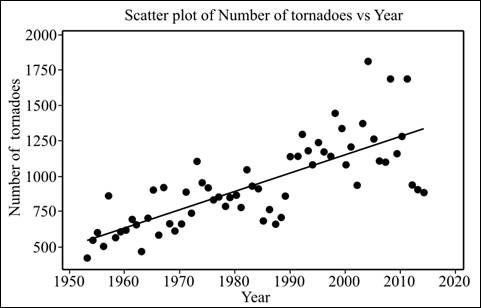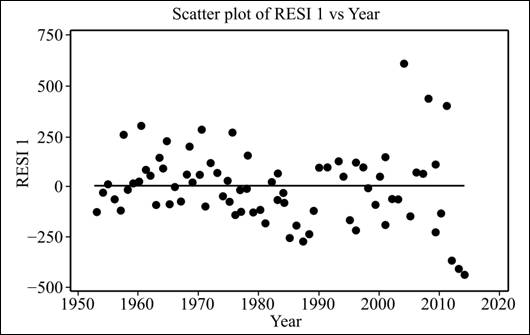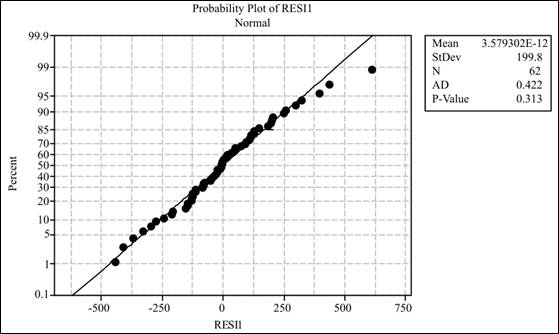
Concept explainers
(a)
Section 1:
To graph: A
(a)
Section 1:
Explanation of Solution
Graph: Construct a scatterplot using Minitab as follows:
Step 1: Enter the data in Minitab.
Step 2: Click on Graph --> Scatterplot. Select scatterplot with regression.
Step 3: Double click on ‘Number of tornadoes’ to move it to Y variable and ‘Year’ to move it to X variable column.
Step 4: Click ‘Ok’ twice to obtain the graph.

Section 2:
To explain: The relationship between two variables seems linear.
Section 2:
Answer to Problem 19E
Solution: The variables are in linear relationship.
Explanation of Solution
Section 3:
To explain: Whether there are any outliers or unusual pattern.
Section 3:
Answer to Problem 19E
Solution: There are no outliers.
Explanation of Solution
(b)
To find: The least square regression line.
(b)
Answer to Problem 19E
Solution: The regression line is:
Explanation of Solution
Calculation: Obtain the regression line using Minitab as follows:
Step 1: Enter the data in Minitab.
Step 2: Click on Stat --> Regression --> Regression.
Step 3: Double click on ‘Number of tornadoes’ to move it to Y variable and ‘Year’ to move it to X variable column.
Step 4: Click on ‘Storage’ and check the box for residuals.
Step 5: Click ‘Ok’ twice to obtain the result.
Hence, the obtained regression line is
(c)
To explain: The intercept of regression equation.
(c)
Answer to Problem 19E
Solution: The fit is correct because intercept is only used when
Explanation of Solution
(d)
Section 1:
To find: The residuals.
(d)
Section 1:
Answer to Problem 19E
Solution: The residuals are as follows:
Years |
Number of tornadoes |
Residuals |
1953 |
421 |
-127.661 |
1954 |
550 |
-11.495 |
1955 |
593 |
18.670 |
1956 |
504 |
-83.164 |
1957 |
856 |
256.001 |
1958 |
564 |
-48.833 |
1959 |
604 |
-21.668 |
1960 |
616 |
-22.502 |
1961 |
697 |
45.663 |
1962 |
657 |
-7.171 |
1963 |
464 |
-213.006 |
1964 |
704 |
14.160 |
1965 |
906 |
203.325 |
1966 |
585 |
-130.509 |
1967 |
926 |
197.656 |
1968 |
660 |
-81.178 |
1969 |
608 |
-146.013 |
1970 |
653 |
-113.847 |
1971 |
888 |
108.318 |
1972 |
741 |
-51.516 |
1973 |
1102 |
296.649 |
1974 |
947 |
128.815 |
1975 |
920 |
88.980 |
1976 |
835 |
-8.854 |
1977 |
852 |
-4.689 |
1978 |
788 |
-81.523 |
1979 |
852 |
-30.358 |
1980 |
866 |
-29.192 |
1981 |
783 |
-125.027 |
1982 |
1046 |
125.139 |
1983 |
931 |
-2.696 |
1984 |
907 |
-39.530 |
1985 |
684 |
-275.365 |
1986 |
764 |
-208.199 |
1987 |
656 |
-329.034 |
1988 |
702 |
-295.868 |
1989 |
856 |
-154.703 |
1990 |
1133 |
109.463 |
1991 |
1132 |
95.628 |
1992 |
1298 |
248.794 |
1993 |
1176 |
113.959 |
1994 |
1082 |
7.125 |
1995 |
1235 |
147.290 |
1996 |
1173 |
72.456 |
1997 |
1148 |
34.621 |
1998 |
1449 |
322.787 |
1999 |
1340 |
200.952 |
2000 |
1075 |
-76.882 |
2001 |
1215 |
50.283 |
2002 |
934 |
-243.551 |
2003 |
1374 |
183.614 |
2004 |
1817 |
613.780 |
2005 |
1265 |
48.945 |
2006 |
1103 |
-125.889 |
2007 |
1096 |
-145.724 |
2008 |
1692 |
437.442 |
2009 |
1156 |
-111.393 |
2010 |
1282 |
1.773 |
2011 |
1691 |
397.938 |
2012 |
938 |
-367.896 |
2013 |
907 |
-411.731 |
2014 |
888 |
-443.565 |
Explanation of Solution
Calculation: Obtain the residuals using Minitab as follows:
Step 1: Enter the data in Minitab.
Step 2: Click on Stat --> Regression --> Regression.
Step 3: Double click on ‘Number of tornadoes’ to move it response column and ‘Year’ to move it to predictor column.
Step 4: Click on ‘Storage’ and check the box for residuals.
Step 5: Click ‘Ok’ to obtain the result.
Hence, the obtained residuals are shown below:
Years |
Number of tornadoes |
Residuals |
1953 |
421 |
-127.661 |
1954 |
550 |
-11.495 |
1955 |
593 |
18.670 |
1956 |
504 |
-83.164 |
1957 |
856 |
256.001 |
1958 |
564 |
-48.833 |
1959 |
604 |
-21.668 |
1960 |
616 |
-22.502 |
1961 |
697 |
45.663 |
1962 |
657 |
-7.171 |
1963 |
464 |
-213.006 |
1964 |
704 |
14.160 |
1965 |
906 |
203.325 |
1966 |
585 |
-130.509 |
1967 |
926 |
197.656 |
1968 |
660 |
-81.178 |
1969 |
608 |
-146.013 |
1970 |
653 |
-113.847 |
1971 |
888 |
108.318 |
1972 |
741 |
-51.516 |
1973 |
1102 |
296.649 |
1974 |
947 |
128.815 |
1975 |
920 |
88.980 |
1976 |
835 |
-8.854 |
1977 |
852 |
-4.689 |
1978 |
788 |
-81.523 |
1979 |
852 |
-30.358 |
1980 |
866 |
-29.192 |
1981 |
783 |
-125.027 |
1982 |
1046 |
125.139 |
1983 |
931 |
-2.696 |
1984 |
907 |
-39.530 |
1985 |
684 |
-275.365 |
1986 |
764 |
-208.199 |
1987 |
656 |
-329.034 |
1988 |
702 |
-295.868 |
1989 |
856 |
-154.703 |
1990 |
1133 |
109.463 |
1991 |
1132 |
95.628 |
1992 |
1298 |
248.794 |
1993 |
1176 |
113.959 |
1994 |
1082 |
7.125 |
1995 |
1235 |
147.290 |
1996 |
1173 |
72.456 |
1997 |
1148 |
34.621 |
1998 |
1449 |
322.787 |
1999 |
1340 |
200.952 |
2000 |
1075 |
-76.882 |
2001 |
1215 |
50.283 |
2002 |
934 |
-243.551 |
2003 |
1374 |
183.614 |
2004 |
1817 |
613.780 |
2005 |
1265 |
48.945 |
2006 |
1103 |
-125.889 |
2007 |
1096 |
-145.724 |
2008 |
1692 |
437.442 |
2009 |
1156 |
-111.393 |
2010 |
1282 |
1.773 |
2011 |
1691 |
397.938 |
2012 |
938 |
-367.896 |
2013 |
907 |
-411.731 |
2014 |
888 |
-443.565 |
Section 2:
To graph: The scatterplot of residual versus year.
Section 2:
Explanation of Solution
Graph: Construct a scatterplot using Minitab as follows:
Step 1: Enter the data in Minitab.
Step 2: Click on Graph --> Scatterplot. Select scatterplot with regression.
Step 3: Double click on ‘Residuals’ to move it to Y variable and ‘Year’ to move it to X variable column.
Step 4: Click ‘Ok’ to obtain the graph.

From the scatter plot, it is clear that the residual plot looks mostly random
(e)
To explain: That residuals are normal or not.
(e)
Answer to Problem 19E
Solution: The residuals are
Explanation of Solution
Graph: Construct the probability plot for residuals to test for the normality using Minitab as follows:
Step 1: Click on Stat -->
Step 2: Double click on ‘Residuals’ to move it to the variable column.
Step 3: Click ‘OK’ to obtain the graph.
Hence, the obtained graph is shown below:

Interpretation: All the points lie near the trend line. Therefore, it can be concluded that residuals are normally distributed.
(f)
To explain: The accuracy of inference based on residual checks.
(f)
Answer to Problem 19E
Solution: The inference can be made based on residuals.
Explanation of Solution
Want to see more full solutions like this?
Chapter 10 Solutions
Introduction to the Practice of Statistics 9E & LaunchPad for Introduction to the Practice of Statistics 9E (Twelve-Month Access)
- 1. A consumer group claims that the mean annual consumption of cheddar cheese by a person in the United States is at most 10.3 pounds. A random sample of 100 people in the United States has a mean annual cheddar cheese consumption of 9.9 pounds. Assume the population standard deviation is 2.1 pounds. At a = 0.05, can you reject the claim? (Adapted from U.S. Department of Agriculture) State the hypotheses: Calculate the test statistic: Calculate the P-value: Conclusion (reject or fail to reject Ho): 2. The CEO of a manufacturing facility claims that the mean workday of the company's assembly line employees is less than 8.5 hours. A random sample of 25 of the company's assembly line employees has a mean workday of 8.2 hours. Assume the population standard deviation is 0.5 hour and the population is normally distributed. At a = 0.01, test the CEO's claim. State the hypotheses: Calculate the test statistic: Calculate the P-value: Conclusion (reject or fail to reject Ho): Statisticsarrow_forward21. find the mean. and variance of the following: Ⓒ x(t) = Ut +V, and V indepriv. s.t U.VN NL0, 63). X(t) = t² + Ut +V, U and V incepires have N (0,8) Ut ①xt = e UNN (0162) ~ X+ = UCOSTE, UNNL0, 62) SU, Oct ⑤Xt= 7 where U. Vindp.rus +> ½ have NL, 62). ⑥Xn = ΣY, 41, 42, 43, ... Yn vandom sample K=1 Text with mean zen and variance 6arrow_forwardA psychology researcher conducted a Chi-Square Test of Independence to examine whether there is a relationship between college students’ year in school (Freshman, Sophomore, Junior, Senior) and their preferred coping strategy for academic stress (Problem-Focused, Emotion-Focused, Avoidance). The test yielded the following result: image.png Interpret the results of this analysis. In your response, clearly explain: Whether the result is statistically significant and why. What this means about the relationship between year in school and coping strategy. What the researcher should conclude based on these findings.arrow_forward
- A school counselor is conducting a research study to examine whether there is a relationship between the number of times teenagers report vaping per week and their academic performance, measured by GPA. The counselor collects data from a sample of high school students. Write the null and alternative hypotheses for this study. Clearly state your hypotheses in terms of the correlation between vaping frequency and academic performance. EditViewInsertFormatToolsTable 12pt Paragrapharrow_forwardA smallish urn contains 25 small plastic bunnies – 7 of which are pink and 18 of which are white. 10 bunnies are drawn from the urn at random with replacement, and X is the number of pink bunnies that are drawn. (a) P(X = 5) ≈ (b) P(X<6) ≈ The Whoville small urn contains 100 marbles – 60 blue and 40 orange. The Grinch sneaks in one night and grabs a simple random sample (without replacement) of 15 marbles. (a) The probability that the Grinch gets exactly 6 blue marbles is [ Select ] ["≈ 0.054", "≈ 0.043", "≈ 0.061"] . (b) The probability that the Grinch gets at least 7 blue marbles is [ Select ] ["≈ 0.922", "≈ 0.905", "≈ 0.893"] . (c) The probability that the Grinch gets between 8 and 12 blue marbles (inclusive) is [ Select ] ["≈ 0.801", "≈ 0.760", "≈ 0.786"] . The Whoville small urn contains 100 marbles – 60 blue and 40 orange. The Grinch sneaks in one night and grabs a simple random sample (without replacement) of 15 marbles. (a)…arrow_forwardSuppose an experiment was conducted to compare the mileage(km) per litre obtained by competing brands of petrol I,II,III. Three new Mazda, three new Toyota and three new Nissan cars were available for experimentation. During the experiment the cars would operate under same conditions in order to eliminate the effect of external variables on the distance travelled per litre on the assigned brand of petrol. The data is given as below: Brands of Petrol Mazda Toyota Nissan I 10.6 12.0 11.0 II 9.0 15.0 12.0 III 12.0 17.4 13.0 (a) Test at the 5% level of significance whether there are signi cant differences among the brands of fuels and also among the cars. [10] (b) Compute the standard error for comparing any two fuel brands means. Hence compare, at the 5% level of significance, each of fuel brands II, and III with the standard fuel brand I. [10] �arrow_forward
- Analyze the residuals of a linear regression model and select the best response. yes, the residual plot does not show a curve no, the residual plot shows a curve yes, the residual plot shows a curve no, the residual plot does not show a curve I answered, "No, the residual plot shows a curve." (and this was incorrect). I am not sure why I keep getting these wrong when the answer seems obvious. Please help me understand what the yes and no references in the answer.arrow_forwarda. Find the value of A.b. Find pX(x) and py(y).c. Find pX|y(x|y) and py|X(y|x)d. Are x and y independent? Why or why not?arrow_forwardAnalyze the residuals of a linear regression model and select the best response.Criteria is simple evaluation of possible indications of an exponential model vs. linear model) no, the residual plot does not show a curve yes, the residual plot does not show a curve yes, the residual plot shows a curve no, the residual plot shows a curve I selected: yes, the residual plot shows a curve and it is INCORRECT. Can u help me understand why?arrow_forward
 MATLAB: An Introduction with ApplicationsStatisticsISBN:9781119256830Author:Amos GilatPublisher:John Wiley & Sons Inc
MATLAB: An Introduction with ApplicationsStatisticsISBN:9781119256830Author:Amos GilatPublisher:John Wiley & Sons Inc Probability and Statistics for Engineering and th...StatisticsISBN:9781305251809Author:Jay L. DevorePublisher:Cengage Learning
Probability and Statistics for Engineering and th...StatisticsISBN:9781305251809Author:Jay L. DevorePublisher:Cengage Learning Statistics for The Behavioral Sciences (MindTap C...StatisticsISBN:9781305504912Author:Frederick J Gravetter, Larry B. WallnauPublisher:Cengage Learning
Statistics for The Behavioral Sciences (MindTap C...StatisticsISBN:9781305504912Author:Frederick J Gravetter, Larry B. WallnauPublisher:Cengage Learning Elementary Statistics: Picturing the World (7th E...StatisticsISBN:9780134683416Author:Ron Larson, Betsy FarberPublisher:PEARSON
Elementary Statistics: Picturing the World (7th E...StatisticsISBN:9780134683416Author:Ron Larson, Betsy FarberPublisher:PEARSON The Basic Practice of StatisticsStatisticsISBN:9781319042578Author:David S. Moore, William I. Notz, Michael A. FlignerPublisher:W. H. Freeman
The Basic Practice of StatisticsStatisticsISBN:9781319042578Author:David S. Moore, William I. Notz, Michael A. FlignerPublisher:W. H. Freeman Introduction to the Practice of StatisticsStatisticsISBN:9781319013387Author:David S. Moore, George P. McCabe, Bruce A. CraigPublisher:W. H. Freeman
Introduction to the Practice of StatisticsStatisticsISBN:9781319013387Author:David S. Moore, George P. McCabe, Bruce A. CraigPublisher:W. H. Freeman





